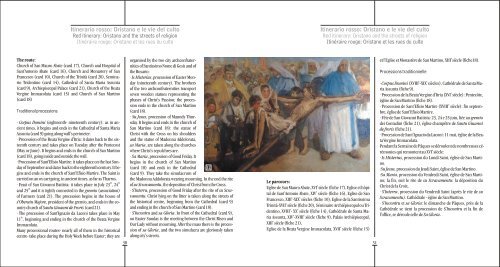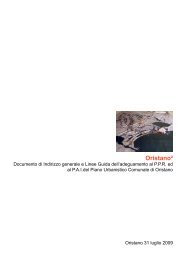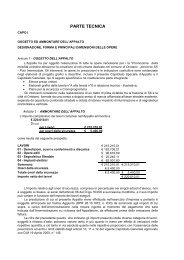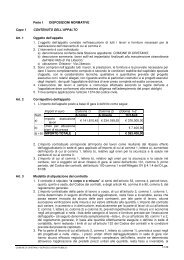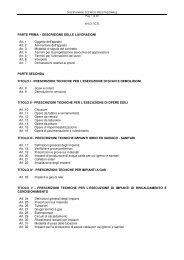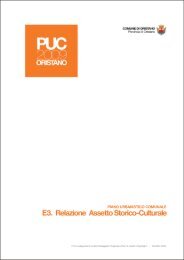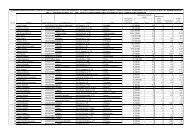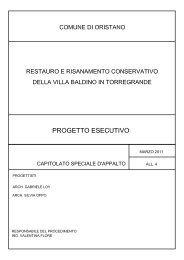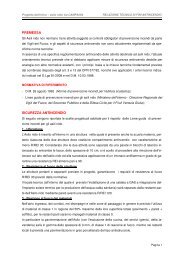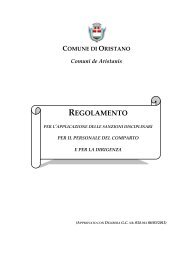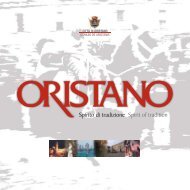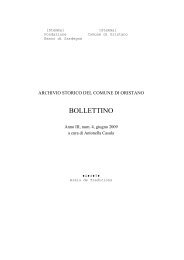Guida PERCORSI.cdr - Comune di Oristano
Guida PERCORSI.cdr - Comune di Oristano
Guida PERCORSI.cdr - Comune di Oristano
You also want an ePaper? Increase the reach of your titles
YUMPU automatically turns print PDFs into web optimized ePapers that Google loves.
The route:<br />
Church of San Mauro Abate (card 17), Church and Hospital of<br />
Sant'Antonio Abate (card 16), Church and Monastery of San<br />
Francesco (card 10), Church of the Trinità (card 20), Seminario<br />
Tridentino (card 14), Cathedral of Santa Maria Assunta<br />
(card 9), Archiepiscopal Palace (card 21), Church of the Beata<br />
Vergine Immacolata (card 15) and Church of San Martino<br />
(card 18)<br />
Tra<strong>di</strong>tional processions<br />
· Corpus Domini (eighteenth- nineteenth century): as in ancient<br />
times, it begins and ends in the Cathedral of Santa Maria<br />
Assunta (card 9) going along wall's perimeter.<br />
· Procession of the Beata Vergine d'Itria: it dates back to the sixteenth<br />
century and takes place on Tuesday after the Pentecost<br />
(May or June). It begins and ends in the church of San Martino<br />
(card 18), going inside and outside the wall.<br />
· Procession of Sant'Efisio Martire: it takes place on the last Sunday<br />
of September and dates back to the eighteenth century. It begins<br />
and ends in the church of Sant'Efisio Martire. The Saint is<br />
carried on an ox cart going, in ancient times, as far as Tharros.<br />
rd th<br />
· Feast of San Giovanni Battista: it takes place in July 23 , 24<br />
th<br />
and 25 and it is tightly connected to the gremio (association)<br />
of Farmers (card 21). The procession begins in the house of<br />
s'Oberaiu Majore, president of the gremio, and ends in the country<br />
church of Santu Giuanni de Froris (card 21).<br />
· The procession of Sant'Ignazio da Laconi takes place in May<br />
th<br />
11 , beginning and en<strong>di</strong>ng in the church of the Beata Vergine<br />
Immacolata.<br />
Many processional routes- nearly all of them in the historical<br />
centre- take place during the Holy Week before Easter; they are<br />
Itinerario rosso: <strong>Oristano</strong> e le vie del culto<br />
Red itinerary: <strong>Oristano</strong> and the streets of religion<br />
Itinéraire rouge: <strong>Oristano</strong> et les rues du culte<br />
organised by the two city archconfraternities<br />
of Santissimo Nome <strong>di</strong> Gesù and of<br />
the Rosario:<br />
· Is Misterius, procession of Easter Monday<br />
(nineteenth century). The brothers<br />
of the two archconfraternities transport<br />
seven wooden statues representing the<br />
phases of Christ's Passion; the procession<br />
ends in the church of San Martino<br />
(card 18).<br />
· Su Jesus, procession of Maundy Thursday.<br />
It begins and ends in the church of<br />
San Martino (card 18): the statue of<br />
Christ with the Cross on his shoulders<br />
and the statue of Madonna Addolorata,<br />
sa Maria, are taken along the churches<br />
where Christ's sepulchres are.<br />
· Sa Maria, procession of Good Friday. It<br />
begins in the church of San Martino<br />
(card 18) and ends in the Cathedral 12<br />
(card 9). They take the simulacrum of<br />
the Madonna Addolorata wearing mourning. In the end the rite<br />
of su Scravamentu, the deposition of Christ from the Cross.<br />
· S'Interru, procession of Good Friday after the rite of su Scravamentu.<br />
Christ lying on the litter is taken along the streets of<br />
the historical centre, beginning from the Cathedral (card 9)<br />
and en<strong>di</strong>ng in the church of San Martino (card 18).<br />
· S'Incontru and sa Gloria. In front of the Cathedral (card 9),<br />
on Easter Sunday is the meeting between the Christ Risen and<br />
Our Lady without mourning. After the mass there is the procession<br />
of sa Gloria, and the two simulacra are gloriously taken<br />
along city's streets.<br />
immagine da cercare<br />
Le parcours:<br />
e<br />
Eglise de San Mauro Abate, XVI siècle (fiche 17), Eglise et hôpie<br />
tal de Sant'Antonio Abate, XIV siècle (fiche 16), Eglise de San<br />
e e<br />
Francesco, XIII -XIX siècles (fiche 10), Eglise de la Santissima<br />
e<br />
Trinità-XVII siècle (fiche 20), Séminaire Archiépiscopal ou Trie<br />
e<br />
dentino, XVIII - XX siècle (fiche 14), Cathédrale de Santa Mae<br />
e<br />
ria Assunta, XIV -XVIII siècle (fiche 9), Palais Archiépiscopal,<br />
e<br />
XIII siècle (fiche 21),<br />
e<br />
Eglise de la Beata Vergine Immacolata, XVII siècle (fiche 15)<br />
Itinerario rosso: <strong>Oristano</strong> e le vie del culto<br />
Red itinerary: <strong>Oristano</strong> and the streets of religion<br />
Itinéraire rouge: <strong>Oristano</strong> et les rues du culte<br />
30 31<br />
e<br />
et l'Eglise et Monastère de San Martino, XIII siècle (fiche18).<br />
Processions tra<strong>di</strong>tionnelle<br />
e e<br />
· Corpus Domini (XVIII -XIX siècles), Cathédrale de Santa Maria<br />
Assunta (fiche 9).<br />
e<br />
· Procession de la Beata Vergine d'Itria (XVI siècle): Pentecôte,<br />
église de San Martino (fiche 18).<br />
e<br />
· Procession de Sant'Efisio Martire (XVIII siècle): fin septem-<br />
bre, église de Sant'Efisio Martire.<br />
· Fête de San Giovanni Battista: 23, 24 e 25 juin, liée au gremio<br />
dei Conta<strong>di</strong>ni (fiche 21), église champêtre de Santu Giuanni<br />
de froris (fiche 21).<br />
· Procession de Sant'Ignazio da Laconi: 11 mai, église de la Beata<br />
Vergine Immacolata.<br />
Pendant la Semaine de Pâques se déroulent de nombreuses cée<br />
rémonies qui remontent au XVI siècle:<br />
· Is Misterius, procession du Lun<strong>di</strong> Saint, église de San Martino.<br />
·Su Jesus, procession du Jeu<strong>di</strong> Saint, église de San Martino.<br />
·Sa Maria, procession du Vendre<strong>di</strong> Saint, église de San Martino;<br />
la fin, suit le rite de su Scravamentu: la déposition du<br />
Christ de la Croix.<br />
· S'Interru, procession du Vendre<strong>di</strong> Saint (après le rite de su<br />
Scravamentu). Cathédrale - église de San Martino.<br />
· S'Incontru et sa Gloria: le <strong>di</strong>manche de Pâques, près de la<br />
Cathédrale se tient la procession de S'Incontru et la fin de<br />
l'office, se déroule celle de Sa Gloria.


